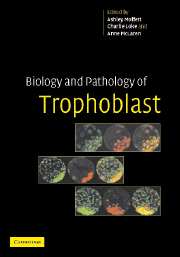Book contents
- Frontmatter
- Contents
- List of contributors
- List of participants
- Preface
- Chair's introduction
- 1 Trophoblast cell fate specification
- 2 Stem cells: pluripotency and extraembryonic differentiation in the mouse
- 3 Epigenetic regulation of trophoblast development
- 4 Regulation of X-chromosome inactivation in relation to lineage allocation in early mouse embryogenesis
- General discussion I
- General discussion II
- Final general discussion
- Index
- Plate section
- References
Chair's introduction
Published online by Cambridge University Press: 07 August 2009
- Frontmatter
- Contents
- List of contributors
- List of participants
- Preface
- Chair's introduction
- 1 Trophoblast cell fate specification
- 2 Stem cells: pluripotency and extraembryonic differentiation in the mouse
- 3 Epigenetic regulation of trophoblast development
- 4 Regulation of X-chromosome inactivation in relation to lineage allocation in early mouse embryogenesis
- General discussion I
- General discussion II
- Final general discussion
- Index
- Plate section
- References
Summary
The origin of this meeting was a rather good dinner in King's College Cambridge, at which Charlie Loke, Ashley Moffett, Barry Keverne, Azim Surani and myself got together, and it occurred to us that the trophoblast as a tissue was shamefully neglected. Since the definition of the word ‘trophoblast’ clearly means ‘original feeding tissue’ it is perhaps appropriate that the meeting had its origins in a good dinner!
Because I have spent a lot of time looking at sections of mouse implantation, seeing the giant mouse trophoblast cells, I have always found trophoblast rather scary. These cells are huge: they are so big they can be seen with the naked eye. In sections they seem to engulf the uterine epithelium and then they engulf the stromal cells. They are very aggressive cells, but they do a remarkable job. Those primary trophoblast cells are directly responsible for the very explosive growth that occurs in mouse implantation during gastrulation. It has been estimated that from the inner cell mass of the 3-day blastocyst (i.e. 3–4 days post coitum (dpc)) up to the 7-day embryo there is a more than 500-fold increase in tissue volume. This is all due to the yolk sac placenta, which does a remarkable job in nourishing and supporting this explosive growth. At 8 days the allantois is growing: it hasn't quite reached the chorion, so we don't have a chorioallantoic placenta, but it is the chorioallantoic placenta which is in a way more remarkable because this supports the entire human fetal growth up to full term – in most cases, fortunately, rather successfully.
- Type
- Chapter
- Information
- Biology and Pathology of Trophoblast , pp. 1 - 2Publisher: Cambridge University PressPrint publication year: 2006



